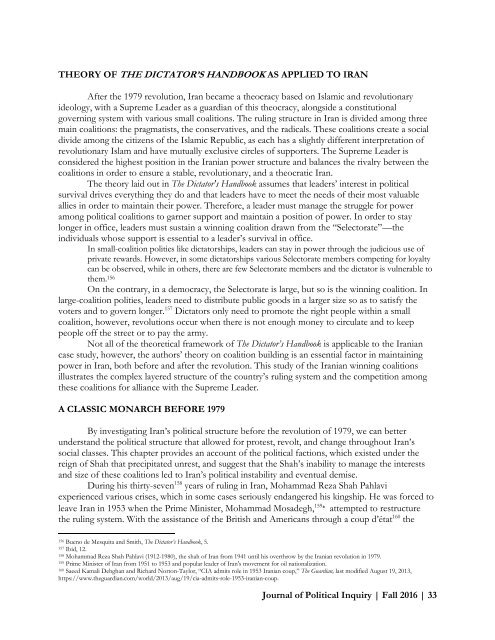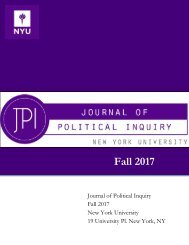Fall2016_Final2
You also want an ePaper? Increase the reach of your titles
YUMPU automatically turns print PDFs into web optimized ePapers that Google loves.
THEORY OF THE DICTATOR’S HANDBOOK AS APPLIED TO IRAN<br />
After the 1979 revolution, Iran became a theocracy based on Islamic and revolutionary<br />
ideology, with a Supreme Leader as a guardian of this theocracy, alongside a constitutional<br />
governing system with various small coalitions. The ruling structure in Iran is divided among three<br />
main coalitions: the pragmatists, the conservatives, and the radicals. These coalitions create a social<br />
divide among the citizens of the Islamic Republic, as each has a slightly different interpretation of<br />
revolutionary Islam and have mutually exclusive circles of supporters. The Supreme Leader is<br />
considered the highest position in the Iranian power structure and balances the rivalry between the<br />
coalitions in order to ensure a stable, revolutionary, and a theocratic Iran.<br />
The theory laid out in The Dictator's Handbook assumes that leaders’ interest in political<br />
survival drives everything they do and that leaders have to meet the needs of their most valuable<br />
allies in order to maintain their power. Therefore, a leader must manage the struggle for power<br />
among political coalitions to garner support and maintain a position of power. In order to stay<br />
longer in office, leaders must sustain a winning coalition drawn from the “Selectorate”—the<br />
individuals whose support is essential to a leader’s survival in office.<br />
In small-coalition polities like dictatorships, leaders can stay in power through the judicious use of<br />
private rewards. However, in some dictatorships various Selectorate members competing for loyalty<br />
can be observed, while in others, there are few Selectorate members and the dictator is vulnerable to<br />
them. 156<br />
On the contrary, in a democracy, the Selectorate is large, but so is the winning coalition. In<br />
large-coalition polities, leaders need to distribute public goods in a larger size so as to satisfy the<br />
voters and to govern longer. 157 Dictators only need to promote the right people within a small<br />
coalition, however, revolutions occur when there is not enough money to circulate and to keep<br />
people off the street or to pay the army.<br />
Not all of the theoretical framework of The Dictator’s Handbook is applicable to the Iranian<br />
case study, however, the authors’ theory on coalition building is an essential factor in maintaining<br />
power in Iran, both before and after the revolution. This study of the Iranian winning coalitions<br />
illustrates the complex layered structure of the country’s ruling system and the competition among<br />
these coalitions for alliance with the Supreme Leader.<br />
A CLASSIC MONARCH BEFORE 1979<br />
By investigating Iran’s political structure before the revolution of 1979, we can better<br />
understand the political structure that allowed for protest, revolt, and change throughout Iran’s<br />
social classes. This chapter provides an account of the political factions, which existed under the<br />
reign of Shah that precipitated unrest, and suggest that the Shah’s inability to manage the interests<br />
and size of these coalitions led to Iran’s political instability and eventual demise.<br />
During his thirty-seven 158 years of ruling in Iran, Mohammad Reza Shah Pahlavi<br />
experienced various crises, which in some cases seriously endangered his kingship. He was forced to<br />
leave Iran in 1953 when the Prime Minister, Mohammad Mosadegh, 159 ∗ attempted to restructure<br />
the ruling system. With the assistance of the British and Americans through a coup d’état 160 the<br />
156<br />
Bueno de Mesquita and Smith, The Dictator’s Handbook, 5.<br />
157<br />
Ibid, 12.<br />
158<br />
Mohammad Reza Shah Pahlavi (1912-1980), the shah of Iran from 1941 until his overthrow by the Iranian revolution in 1979.<br />
159<br />
Prime Minister of Iran from 1951 to 1953 and popular leader of Iran's movement for oil nationalization.<br />
160<br />
Saeed Kamali Dehghan and Richard Norton-Taylor, “CIA admits role in 1953 Iranian coup,” The Guardian, last modified August 19, 2013,<br />
https://www.theguardian.com/world/2013/aug/19/cia-admits-role-1953-iranian-coup.<br />
Journal of Political Inquiry | Fall 2016 | 33
















